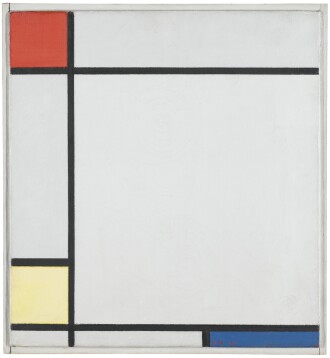Works by Piet Mondrian at Sotheby's
Piet Mondrian Biography
Born as Pieter Cornelis Mondriaan in 1872 in Amersfoort, the Netherlands, Piet Mondrian began studying drawing at the age of 14. Despite his certainty that he wanted to pursue a career in art, Mondrian first earned a degree in education at the insistence of his family. Though he was in a position to assume a teaching role following his studies, he instead undertook painting classes near his hometown before moving to Amsterdam to study at the Rijksacademie, exhibiting for the first time 1893.
Though his works by the dawn of the 20th century were largely representative of the popular motifs and styles of the time, such as landscapes and still lifes, a trip to the austere landscapes of Branant, Belgium, in 1903 proved an important inspiration for the further development of his practice, and by 1905 his work began exhibiting a more pronounced linear quality. Later in the decade, and after becoming well acquainted with The Luminists (a scion of Neo-Impressionism), Mondrian’s signature use of primary colors began to emerge; the paintings he completed within the Luminist mode were exhibited in the Stedelijk Museum in Amsterdam in 1909, solidifying his place within the Dutch avant-garde. Following the success of his Luminist works, Mondrian began studying theosophy, and experimented with Cubism, resulting from his exposure to the works of Pablo Picasso and Georges Braque.
Following the turn of the century, Mondrian’s style continually discarded facets of representation, and even through his Cubist period he continually abandoned representational signifiers, such as curved lines. In 1917, along with fellow artists Theo van Doesburg, Vilmos Huszar and Bart van der Leck, Mondrian became a co-founder of the De Stijl movement via an eponymous journal, which promoted a visual style that wholly rejected representation and promoted the use of visual fundamentals only—which, for them, included straight lines, primary colors, and the gray scale. The tenets of the movement Mondrian would eventually term “neoplasticism.”
Mondrian’s progressive and increasingly stark works were well received, and he was the subject of a retrospective at the Stedelijk Museum in Amsterdam the year of his 50th birthday. Unfortunately, the rise of Adolf Hitler forced the artist to flee to New York in 1940, but the new, lively city proved an important source of inspiration for his late works. He began incorporating vibrant color planes and bands into his works, resulting in a late body of work that includes such masterpieces as Broadway Boogie Woogie (created in 1942–43). Mondrian continued to work and expand his artistic practice until his death in 1944.
Today, Mondrian is considered a seminal figure within the development of abstraction, and his oeuvre exerted significant influence on subsequent artists and movements, including the Bauhaus and later Minimalism. His works are included in numerous prestigious museum collections worldwide, including the Museum of Modern Art, New York, the Museé d’Orsay, Paris, Kunstmuseum Basel, and the Stedelijk Museum, Amsterdam.












